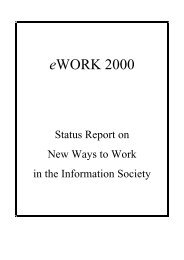Proceedings of 8th European Assembly on telework (Telework2001)
Proceedings of 8th European Assembly on telework (Telework2001)
Proceedings of 8th European Assembly on telework (Telework2001)
Create successful ePaper yourself
Turn your PDF publications into a flip-book with our unique Google optimized e-Paper software.
194BoundlessnessThe drawback <str<strong>on</strong>g>of</str<strong>on</strong>g> the network structures is their boundlessness. The erosi<strong>on</strong> <str<strong>on</strong>g>of</str<strong>on</strong>g> traditi<strong>on</strong>al workrelati<strong>on</strong>s, <str<strong>on</strong>g>of</str<strong>on</strong>g> the so-called regular employment relati<strong>on</strong>ship with full-time permanent employmentc<strong>on</strong>tract, with a stable distributi<strong>on</strong> <str<strong>on</strong>g>of</str<strong>on</strong>g> working hours over a fixed number <str<strong>on</strong>g>of</str<strong>on</strong>g> days per week.How can people deal with that newly gained freedom, if the structures that had also <str<strong>on</strong>g>of</str<strong>on</strong>g>fered securityand orientati<strong>on</strong> become frail or even disappear?What is likely to create identity in the organisati<strong>on</strong> bey<strong>on</strong>d all bounds and what helps to keepworking c<strong>on</strong>diti<strong>on</strong>s human in the new envir<strong>on</strong>ment.? These are questi<strong>on</strong>s which must be answered,if the hopes placed <strong>on</strong> the knowledge-based ec<strong>on</strong>omy are to meet human needs.Increasing complexityWith the increasingly dynamic changes and the networked structures, the resulting problemsare becoming increasingly complex. Flexibilizati<strong>on</strong> and individualisati<strong>on</strong> - as c<strong>on</strong>sequences -c<strong>on</strong>tribute to even higher complexity. The management and communicati<strong>on</strong>s requirements causedby the multitude <str<strong>on</strong>g>of</str<strong>on</strong>g> work time models applied within <strong>on</strong>e company are just a simple example. Notto speak <str<strong>on</strong>g>of</str<strong>on</strong>g> the inscrutable structures <str<strong>on</strong>g>of</str<strong>on</strong>g> communicati<strong>on</strong>s in the network.Individuals and organisati<strong>on</strong>s are faced with growing requirements for c<strong>on</strong>tinuous learning. Theseparati<strong>on</strong>/distincti<strong>on</strong> between (formal) learning and working becomes an obstacle to copingwith rapidly changing processes. Therefore the relati<strong>on</strong> between learning and working has to beredefined. A (re)integrati<strong>on</strong> <str<strong>on</strong>g>of</str<strong>on</strong>g> learning into the work process and the appropriate organisati<strong>on</strong> <str<strong>on</strong>g>of</str<strong>on</strong>g>work are essential. That is <strong>on</strong>e <str<strong>on</strong>g>of</str<strong>on</strong>g> the less<strong>on</strong>s learned from the transformati<strong>on</strong> process in EasternGermany after the reunificati<strong>on</strong>.The new framework programme ”Innovative Workplace Development andthe Future <str<strong>on</strong>g>of</str<strong>on</strong>g> Work”This envir<strong>on</strong>ment set the basic parameters when the German Federal Ministry <str<strong>on</strong>g>of</str<strong>on</strong>g> Educati<strong>on</strong> andResearch in January 2001 launched a new framework programme 1 <strong>on</strong> research and development(R&D) in the field <str<strong>on</strong>g>of</str<strong>on</strong>g> ”Innovative Workplace Development and the Future <str<strong>on</strong>g>of</str<strong>on</strong>g> Work”.It is set up as an open framework for research and development and is to be understood as a‘learning programme’. Based <strong>on</strong> the analysis <str<strong>on</strong>g>of</str<strong>on</strong>g> issues <str<strong>on</strong>g>of</str<strong>on</strong>g> high priority, projects will be defined andcarried out step by step. The emerging results will be fed back in a m<strong>on</strong>itoring process to allownecessary changes.The first term will last for 5 years with a budget that amounts to 150 milli<strong>on</strong> DM (75 Mio Euro)(approx. 30 Mio DM per year).The aim <str<strong>on</strong>g>of</str<strong>on</strong>g> the programmeThe programme is part <str<strong>on</strong>g>of</str<strong>on</strong>g> the Federal Government’s goals for research policy during the 14thlegislature which places a str<strong>on</strong>g emphasis <strong>on</strong> research to improve living and working c<strong>on</strong>diti<strong>on</strong>s.The aim <str<strong>on</strong>g>of</str<strong>on</strong>g> the programme is to identify and to develop innovative c<strong>on</strong>cepts that are suitable forthe work-life <str<strong>on</strong>g>of</str<strong>on</strong>g> tomorrow. They are expected to c<strong>on</strong>tribute to• improving the effectiveness and quality <str<strong>on</strong>g>of</str<strong>on</strong>g> working life,• supporting a socially-balanced structural change,• and encouraging more high-quality employment.1 Bundesministerium für Bildung und Forschung: (2001) Innovative Arbeitsgestaltung - Zukunft der Arbeit Rahmenk<strong>on</strong>zept








